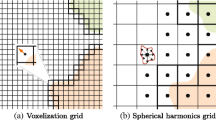Abstract
We present a new method based on GPU acceleration for real-time transparency and translucency rendering. Our method computes refraction at both the front and back sides of a transparent object, as well as internal reflection, thus delivering interactive realistic transparency effects on a commodity PC. The real-time performance is made possible by a new acceleration data structure, called geocube, that enables the use of GPU for fast ray-surface intersection testing. In addition, within the same framework, we introduce the novel use of the mip-map for a hierarchical representation of a sequence of key prefiltered environment maps to simulate translucency. By taking ray depth into account and using GPU to interpolate the key filtered maps to produce the desired blurring effects, we achieve real-time realistic translucency rendering of slightly scattering media that allows show-through of background details.
Similar content being viewed by others
References
Akenine-Moller T, Haines E (2003) Real-Time Rendering, 2nd edn. A.K. Peters, Wellesley, MA
Carr N, Hall J, Hart J (2003) GPU algorithm for radiosity and subsurface scattering. In: Proceedings of Graphics Hardware ’03
Chandrasekhar S (1964) Radiative Transfer. Dover, New York
Hao X, Varshney A (2004) Real-time rendering of translucent meshes. ACM Trans Graph 23:120–142
Jensen H, Christensen P (1998) Efficient simulation of light transport in scences with participating media using photon maps. In: Proceedings of SIGGRAPH ’98, pp 311–320
Jensen H, Marschner S, Levoy M, Hanrahan P (2001) A practical model for subsurface light transport. In: Proceedings of SIGGRAPH ’01, pp 511–518
Kautz J, Vazquez P, Heidrich W, Seidel H (2000) A unified approach to prefiltered environment maps. In: Proceedings of EG Rendering Workshop ’00
Purcell T, Buck I, Mark WR, Hanrahan P (2002) Ray tracing on programmable graphics hardware. ACM Trans Graph 21:703–712
Reinhard E, Smith B, Hansen C (2000) Dynamic acceleration structure for interactive ray tracing. In: Rendering Techniques 2000: 11th Eurographics Workshop on Rendering, pp 299–306
Schroeder W, Martin K, Loresen B (1998) The Visualization Toolkit, 2nd edn. Prentice-Hall, Englewood Cliffs, NJ
Sloan P, Kautz J, Snyder J (2002) Precomputed radiance transfer for real-time rendering in dynamic, low-frequency lighting environments. In: Proceedings of SIGGRAPH ’02, pp 527–536
Smith A, Blinn J (1996) Blue screening matting. In: Proceedings of SIGGRAPH ’96, pp 259–268
Wald I, Benthin C, Dietrich A, Slusallek P (2003) Interactive ray tracing on commodity pc clusters. In: Proceedings of EuroPar 2003, pp 499–508
Wald I, Slusallek P, Benthin C (2001) Interactive distributed ray tracing of highly complex models. In: Rendering Techniques 2001: 12th Eurographics Workshop on Rendering, pp 277–288
Author information
Authors and Affiliations
Corresponding author
Rights and permissions
About this article
Cite this article
Chan, B., Wang, W. Geocube – GPU accelerated real-time rendering of transparency and translucency. Visual Comput 21, 579–590 (2005). https://doi.org/10.1007/s00371-005-0312-4
Published:
Issue Date:
DOI: https://doi.org/10.1007/s00371-005-0312-4




